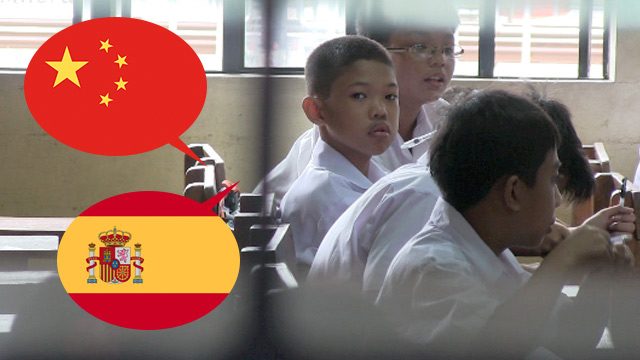SUMMARY
This is AI generated summarization, which may have errors. For context, always refer to the full article.

MANILA, Philippines – At least two senators suggested that the Chinese and Spanish languages be included in the K to 12, ironically a program known for advocating learning through the mother tongue.
“There should be more effort to incentivize schools to provide these courses, and at an earlier level…. Let’s start with those two, Chinese and Spanish, which are unique because of our history,” Senator Juan Edgardo Angara said during a Senate committee hearing on preparations for K to 12 on Tuesday, April 14.
But Elvin Uy, the K to 12 coordinator of the Department of Education, said foreign language is not a core subject in senior high school, although it “may be offered as an elective” under the academic track’s general academic strand.
Angara said many opportunities will open up to Filipinos if the new curriculum taps into learning Spanish. For example, the country is already opening itself to cruise tourism.
“There are cruise companies which employ as many as 60% of Filipinos in their workforce, and some of the biggest cruisers are Spanish-speaking countries, so imagine the employment opportunities not only in the Philippines but abroad,” he added.
The point is to match the curriculum with the “internationalization of Filipinos…with the view to bringing Filipinos and the jobs home.” (READ: K to 12: 80-hour subject on disaster readiness ‘too much’?)
Senator Pia Cayetano also pushes for the inclusion of the two languages in the K to 12 curriculum, but for more sentimental reasons.
“I don’t know of any other country that has access to a very strong Spanish-speaking past. The generation before us…they are the last generation to speak Spanish to their children. I have friends whose parents spoke Spanish to them,” the chairperson of the committee on education, arts, and culture said.
Both Angara and Cayetano said it’s time to learn these foreign languages since the country is already “over those days where it detracts from our nationalism.”
English in PH ‘deteriorating’
But how are Filipinos doing with one of the country’s official languages for communication and instruction, English?
According to Gisela Concepcion, vice president for academic affairs at the University of the Philippines, English proficiency in the country “has come down significantly” and is “deteriorating” specifically among students in public high schools and colleges.
“It’s something we need to address ourselves, and it doesn’t help that 90% of English teachers in Thailand are Filipino, so we have to find a way to keep English teachers in the country,” she said.
Roger Bartholomew from the International Education Specialists said the K to 12 curriculum must include an assessment that will find out how students’ English is progressing.
“According to experts, English language develops in different countries, in different ways where English is used, so there is no reason why there shouldn’t be a Philippine version of English, but I believe English testing is important,” he added.
The K to 12 program will be fully implemented in 2016 as the first batch of senior high school students enters grade 11.(INFOGRAPHIC: 10 things about K to 12) – Rappler.com
Add a comment
How does this make you feel?
There are no comments yet. Add your comment to start the conversation.